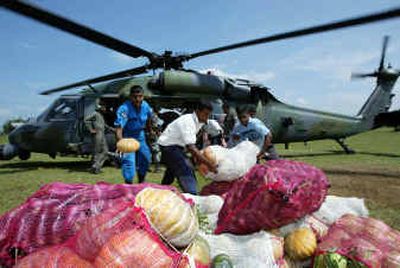Outpouring of aid includes unusables

GALLE, Sri Lanka – In one of the largest relief efforts in history, a new issue is cropping up: mismatched aid.
Relief groups have opened boxes meant for tsunami survivors to discover coats sent by donors apparently unaware the island nation is in the tropics, as well as polyester shirts and pants, which don’t absorb sweat, and fleece baby clothes.
“They’d melt to death,” said Pam Porodo, co-founder of Impakt Aid, a recently formed independent group working out of Colombo, the Sri Lankan capital.
Westerners touched by the suffering have also sent food, generously emptying out their larders of items that might be standard fare back home but don’t quite work locally.
Canned mixed vegetables in cream sauce are one example. First of all, most locals don’t have a can opener. Secondly, people here eat fresh vegetables and most don’t like the taste of creamed or canned food, or may get sick from it.
“The Sri Lankans can be very stubborn about what they eat, even if they go hungry,” said Michelle Cornman, 28, a special education teacher helping with relief efforts. “And the wrong foods disrupt their system.” Sri Lankans and local charity groups say they are incredibly grateful for the global outpouring of help and support. At this point, a growing number of communities are no longer short of basics.
For example, in the relatively remote Ottusuttan refugee camp in northeastern Sri Lanka, several hours from the nearest paved road, over 300 displaced people are now receiving three meals and two snacks a day.
At several camps in the south, including the Wijitharama Buddhist temple in Dewata, children have begun using 5-foot-high piles of donated clothes as an unofficial playground.
With essentials less of a worry, it is becoming increasingly clear that what tsunami victims are receiving is not always the most effective use of resources.
Some of this is inevitable, humanitarian groups say, given the huge gap in culture, distance and lifestyles between well-intentioned donors in wealthy countries and impoverished refugees on the ground. Aid shipments have included items that are not only extravagant by local standards – including expensive organic bath gels and body lotions – but from such a different cultural world as to be strange and unusable to impoverished Sri Lankans.
Even some items that hit the mark are viewed with mixed emotions by those working in the trenches. Children’s designer shirts with their $40 price tags still attached, or boxes of flip-flops that cost $25 in postage alone to send, are certainly useful. Yet that amount of money spent locally could buy 20 or 30 times as many items in styles the locals prefer, even as the money helps rebuild the economy.
Mismatches extend to temporary housing. The Netherlands immediately sent 1,200 tents 14-feet high and made of heavy canvas. The problem is they’re too big. Most people want to live on the site of their ruined houses, which are small and often still rubble-filled.
“It’s a bit of a shame,” said Olof van Joolen, a reporter with the Algemeen Dagblad newspaper following Dutch relief efforts. “They’re sitting unused in a warehouse in Colombo.”
Over the past two weeks, more than 160 international flights have brought tons of rice, lentils, wheat flour and canned fish. Much more aid is in the pipeline.
In the grand scheme of things, the mismatches are minor inconveniences relative to the bigger job of making sure people have food in their stomach and a roof over their head. But they also represent missed opportunities.
Sometimes it’s more of a case of what isn’t being sent than what is. For example, no one has shipped women’s sanitary products, which are in urgent need.
“Women are shy, even in the store, to ask for such things,” said Malage Patmini, 42, a resident of Unawatuna Beach Road who lost six relatives in the tsunami. “A couple of days after the storm, I had my period and sent my daughter looking. She had to go to a store two hours each way to find some. There are almost none left anywhere.”
A few aid groups have started distributing special women’s packets. But local women don’t always know how to use foreign sanitary products, they say, requiring special instructions. Nor do they always have the right clothes. Some groups are now including underwear in the packets as well.